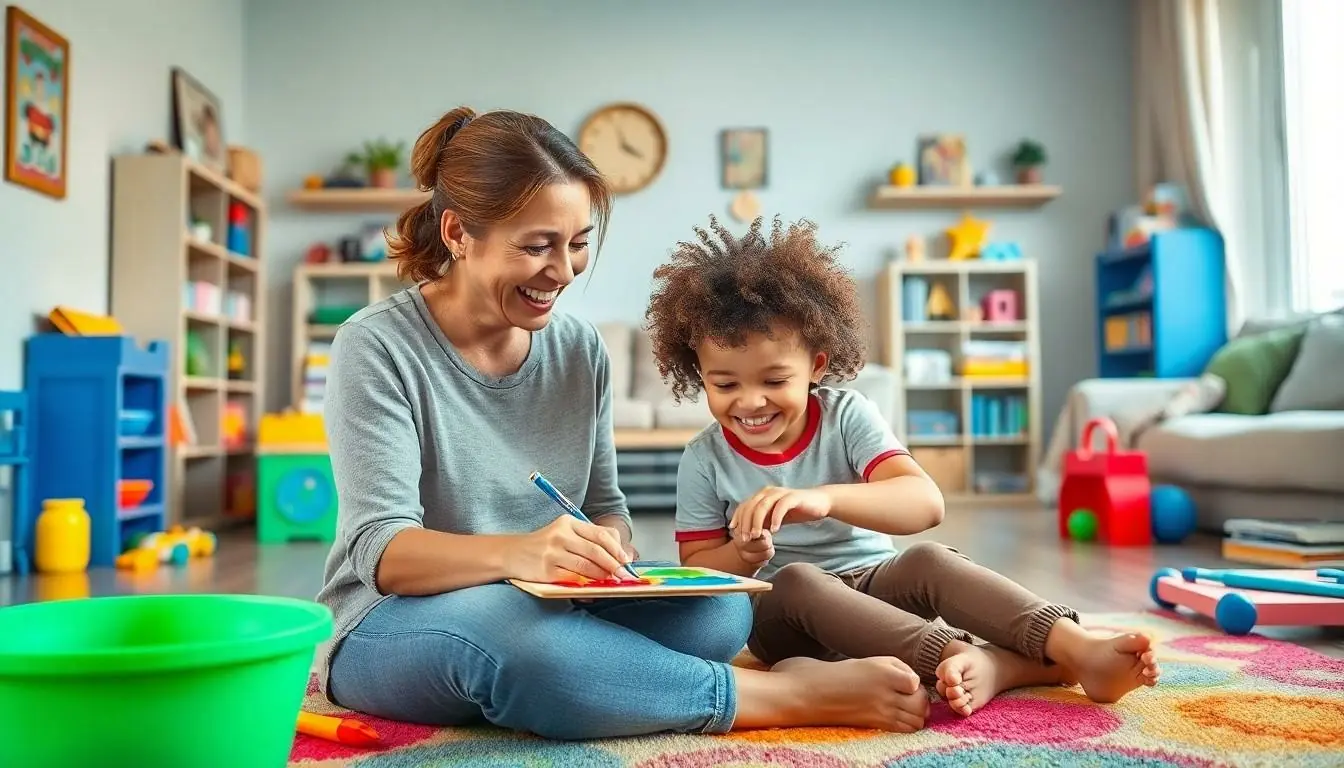Learning shapes, colors, and ABCs doesn’t always require a traditional classroom setting. More parents are discovering that homeschooling preschool can be an exciting adventure filled with finger painting, story time, and counting cheerios – all while wearing pajamas if they choose!
The concept of homeschooling preschoolers has gained significant momentum, especially since 2020. Parents are realizing they can provide their little ones with a solid educational foundation while maintaining flexibility and creating personalized learning experiences. It’s not just about avoiding steep preschool tuition – it’s about crafting those precious early learning moments in a way that best suits each unique child’s needs and learning style.
Table of Contents
ToggleWhat Is Homeschool Preschool
Homeschool preschool transforms a home environment into an early learning center for children ages 3-5. Parents serve as primary educators, delivering age-appropriate lessons through structured activities mixed with play-based learning experiences.
A typical homeschool preschool day includes:
- Educational activities like alphabet recognition
- Creative projects such as painting or crafting
- Physical movement through dance or outdoor play
- Basic math concepts using household items
- Reading sessions with picture books
The core components of homeschool preschool encompass:
- Customized Learning Schedule
- Flexible daily routines
- Adaptable lesson pacing
- Natural learning opportunities
- Educational Focus Areas
- Pre-reading skills
- Number recognition
- Fine motor development
- Social emotional growth
- Basic life skills
- Learning Environment
- Dedicated study space
- Educational materials
- Hands-on resources
- Age-appropriate toys
This educational approach differs from traditional preschools by offering:
| Feature | Homeschool Preschool | Traditional Preschool |
|---|---|---|
| Class Size | 1-3 children | 12-24 children |
| Schedule | Flexible timing | Fixed hours |
| Attention | One-on-one focus | Shared attention |
| Cost | $500-1500/year | $4000-12000/year |
| Curriculum | Customizable | Standardized |
Parents integrate educational moments into daily activities, creating a seamless blend of structured learning time with regular household routines. Each learning session spans 15-30 minutes, matching young children’s attention spans while maintaining engagement through interactive activities.
Benefits of Homeschooling During Preschool Years
Homeschooling during preschool years offers distinct advantages that support early childhood development. Parents create tailored learning experiences that match their child’s developmental stage while maintaining a nurturing environment.
Academic Flexibility and Customization
Homeschooling provides complete control over the preschool curriculum structure. Parents adjust learning activities based on their child’s interests, such as extending time for favorite subjects or introducing new topics when curiosity peaks. A child who shows early interest in numbers gets extra counting games while another who loves letters receives additional phonics activities. This flexibility allows for spontaneous learning moments throughout the day, from counting groceries to identifying shapes during nature walks.
Individual Attention and Pacing
One-on-one instruction enables parents to identify learning preferences immediately. A child struggling with scissors receives extra fine motor practice through activities like playdough manipulation or bead stringing. Quick learners move ahead without waiting for peers while those needing more time master skills at their own speed. Parents observe subtle cues indicating understanding or confusion, adapting teaching methods instantly to maintain engagement.
Safe Learning Environment
The home setting eliminates common preschool stressors like separation anxiety or peer pressure. Children explore new concepts in familiar surroundings with trusted family members. Parents monitor all social interactions, addressing challenges like sharing or turn-taking in real-time. The controlled environment reduces exposure to illness while maintaining consistent routines that promote emotional security. Learning materials stay sanitized according to family standards, creating a healthy space for daily activities.
Essential Components of a Preschool Homeschool Program
A successful preschool homeschool program incorporates structured elements that support early childhood development. These components create a foundation for learning while maintaining the flexibility of home education.
Daily Schedule and Routine
Effective homeschool preschool schedules follow a consistent pattern of activities throughout the day. Morning sessions focus on core learning activities like alphabet practice, counting exercises, and reading time during peak attention spans. Educational blocks last 15-20 minutes each, rotating between subjects to maintain engagement. Physical activities include outdoor play, dance sessions, and fine motor skill development through crafts. Structured learning takes place from 9-11 AM, followed by lunch, rest periods, and afternoon enrichment activities. Parents integrate learning opportunities into daily tasks like sorting laundry by color or counting items during meal preparation.
Learning Materials and Resources
Essential preschool materials include:
- Educational manipulatives: counting blocks, pattern cards, shape sorters
- Art supplies: washable markers, child-safe scissors, construction paper
- Reading materials: picture books, alphabet cards, sight word flashcards
- Sensory items: play dough, sand tables, water toys
- Fine motor tools: chunky crayons, lacing cards, puzzles
Parents organize these materials in designated learning spaces using labeled storage bins, rotating items monthly to maintain interest. Digital resources complement physical materials through educational apps, interactive stories, and virtual field trips.
Social Activities
Homeschooled preschoolers engage in social development through:
- Weekly playgroups with other homeschool families
- Library storytime sessions
- Community sports programs
- Art classes at local centers
- Nature exploration groups
Structured interactions occur 2-3 times weekly, providing opportunities for sharing, turn-taking, and cooperative play. Children practice social skills through organized activities like group projects, music circles, and supervised playdates. Local homeschool networks facilitate regular meetups, ensuring consistent peer interaction and community connection.
Teaching Methods for Homeschool Preschoolers
Effective homeschool preschool teaching incorporates diverse methodologies that align with young children’s natural learning patterns. These methods focus on engaging multiple senses while maintaining age-appropriate educational objectives.
Play-Based Learning
Play-based learning creates natural opportunities for preschoolers to develop cognitive social emotional skills through structured play activities. Children absorb mathematical concepts by sorting toys counting blocks stacking shapes. Language development flourishes during pretend play sessions with puppets dolls dramatic scenarios. Educational games teach colors numbers letters while maintaining engagement through fun interaction. Interactive storytelling sessions encourage vocabulary growth comprehension skills creative thinking.
| Play-Based Learning Activities | Skills Developed |
|---|---|
| Block building | Spatial awareness math |
| Puppet shows | Language expression |
| Sorting games | Classification logic |
| Dramatic play | Social skills creativity |
Hands-On Activities
Hands-on activities engage preschoolers through direct manipulation of learning materials objects. Sensory bins filled with rice beans buttons develop fine motor skills mathematical understanding. Art projects using paint clay scissors strengthen hand coordination creative expression. Science experiments with simple household items teach cause effect relationships observation skills. Cooking activities incorporate measurement counting following instructions practical life skills.
| Activity Type | Learning Benefits |
|---|---|
| Sensory play | Motor skills exploration |
| Art projects | Creative expression coordination |
| Science experiments | Critical thinking observation |
| Cooking | Math skills following directions |
Creating a Preschool Learning Space at Home
A dedicated learning area transforms any room into an effective preschool environment. Strategic organization of educational materials in accessible storage containers enables children to develop independence while maintaining order.
Essential elements of a home preschool space include:
- Low shelves displaying age appropriate toys such as wooden blocks or puzzles
- Cozy reading nook with soft cushions and picture books
- Art station equipped with washable markers, crayons and paper
- Open floor space for movement activities and circle time
- Child sized table and chairs for writing and crafts
- Storage bins labeled with pictures for easy cleanup
Learning zones enhance the educational experience:
- Literacy Corner: Letter magnets, alphabet charts, writing materials
- Math Area: Counting bears, shape sorters, number cards
- Science Center: Magnifying glasses, nature collections, simple experiments
- Creative Space: Play dough, paint supplies, craft materials
- Dramatic Play: Dress up clothes, pretend kitchen items, puppets
Practical setup considerations:
- Position materials at child height for easy access
- Install adequate lighting near work areas
- Create clear pathways between activity zones
- Place messy play areas near water sources
- Use washable rugs for floor activities
- Display children’s artwork at eye level
The space adapts as learning needs change throughout the year. Regular rotation of materials maintains engagement while reducing visual clutter. Natural light and proper ventilation create an inviting atmosphere conducive to learning through play.
- Rolling carts for art materials
- Clear containers for manipulatives
- Labeled baskets for themed activities
- Wall mounted organizers for papers
- Cubbies for personal items
- Book displays facing forward
Legal Requirements and Regulations
Each state maintains distinct homeschool preschool regulations with varying levels of oversight. Families in states like Texas exercise complete freedom in curriculum choices while those in New York follow specific guidelines for documentation.
Homeschool preschool requirements include:
- Registration with local school districts in 10 states
- Annual assessment records in 6 states
- Attendance tracking in 15 states
- Progress documentation in 8 states
| State Category | Number of States | Requirements |
|---|---|---|
| No Regulation | 12 | None |
| Low Regulation | 15 | Basic notification |
| Moderate | 18 | Notification plus assessments |
| High Regulation | 5 | Multiple requirements |
Parents operating home preschools face additional considerations when teaching multiple children:
- Obtaining necessary permits for group sizes exceeding 4 non-family members
- Meeting local zoning requirements for home-based educational programs
- Following state-specific safety protocols
- Maintaining proper insurance coverage
Legal compliance strategies include:
- Joining state homeschool associations for updated regulation information
- Keeping detailed records of educational activities
- Creating portfolios of student work
- Documenting socialization opportunities
- Maintaining communication with local education authorities
State reporting varies significantly:
- 25 states require no formal notification
- 10 states mandate annual progress reports
- 8 states request quarterly updates
- 7 states implement portfolio reviews
Parents monitor changes in local regulations through official state education websites or homeschool support organizations. Compliance documentation includes attendance logs, curriculum plans, activity calendars, assessment records, field trip reports, health records, safety certificates.
Conclusion
Homeschooling preschool offers a unique opportunity for parents to create personalized learning experiences that meet their children’s individual needs. The combination of flexible schedules structured learning environments and one-on-one attention sets a strong foundation for future academic success.
Parents who choose this path can provide their children with tailored educational experiences while fostering emotional security and healthy routines. With proper planning dedicated learning spaces and adherence to state regulations homeschooling preschool can be an enriching journey for both parents and children.
The growing popularity of homeschooling preschool reflects its effectiveness as an educational choice that empowers families to take an active role in their children’s early education while creating lasting memories together.




